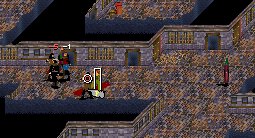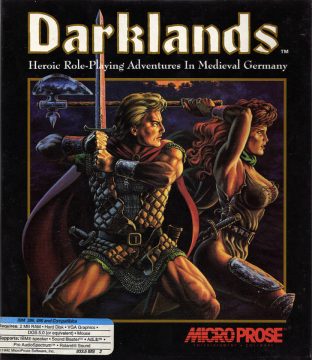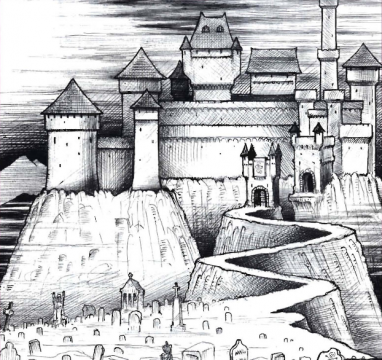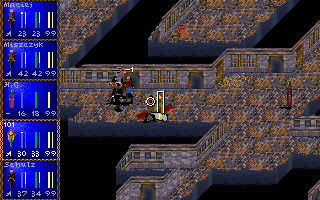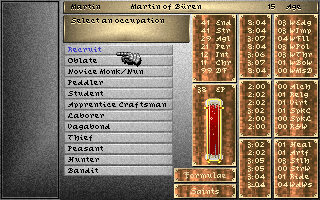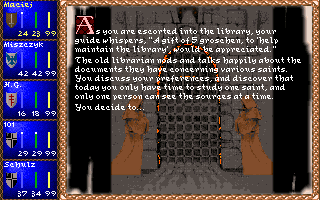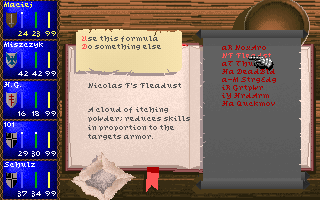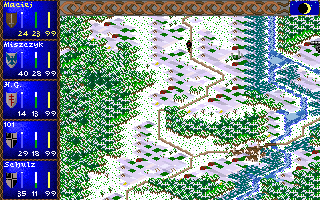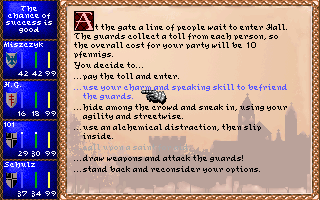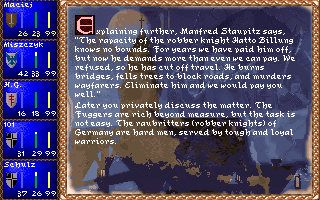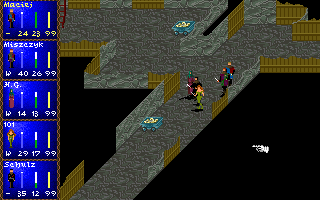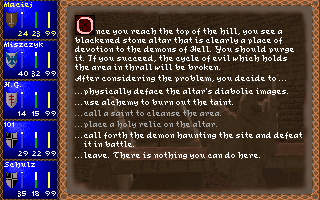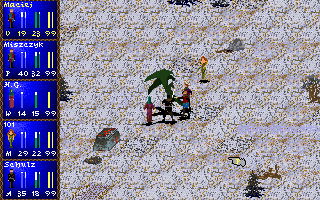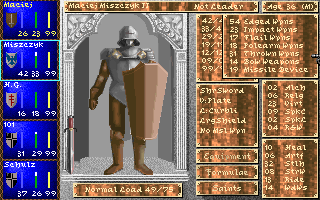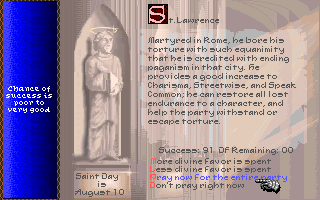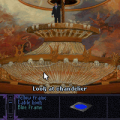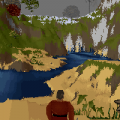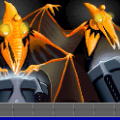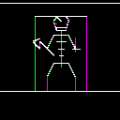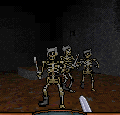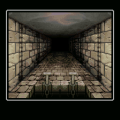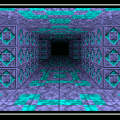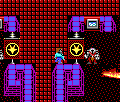Darklands is a role-playing game released in 1992 by MicroProse and developed by its in-house studio MPS Labs. The game is notable for its setting, which blends s detailed and realistic representation of 15th century Germany with medieval German folktales and legends – the world where kobolds, dragons, witches and demons exist but usually stay hidden in deep forests or beneath the earth, rarely seen but often spoken about by drunk people at the local inn. There’s a lot of fantasy elements in this game but before you get to them, you’re going to deal with the more mundane aspects of medieval life – travelling the dangerous roads, paying toll to enter the cities, working odd jobs and attending religious ceremonies.
Darklands is a sandbox game with no real goals other than becoming famous through your adventures – there is a long quest about satanic cults trying to summon Baphomet, which serves as a main story arc, but it only comes up after you do a few specific quests, can be safely ignored and doesn’t end the game when completed.
After the party is created, the game begins with the characters dropped into an inn in a randomly chosen city, and everything from that point onwards is decided by the player. You can either start the game with a premade party or create your own characters through a fairly involved process. In addition to redistributing points between stats and skills, you must pick a family background, which affects stats and available jobs, and a series of occupations. Each of those further affects skills and stats, determines how far each skill can be raised and ages the character by five years. As stats decrease with age and characters age during the game, the number of occupations is extremely important – younger characters are less skilled (and some skills are very hard to raise) but the older ones will be weaker and they will eventually die.
It’s hard to express just how non-linear this game can be. Everything can be solved in at least three standard ways – by fighting, using alchemy or praying for the help of an appropriate saint. In addition to those, many events have checks for one or more of the relevant character skills. While they’re not equal and some are more useful than the others, each of them has its uses. Being good at talking in the common German language may help you convince the guards to let you into the city without paying, a skilled rider can outrun angry wild animals and a scholar with a deep knowledge of religion is likely to befriend priests and monks. When fighting a hopeless battle, it’s possible to surrender.
Even defeat does not necessarily end the game, as characters have two lifebars – running out of endurance leads to a knockout and strength loss, which weakens the character and kills them if they run out completely; it’s harder to lose strength but also harder to regain it, as it requires resting in a camp or inn. When losing a battle, the game will react in a realistic way – guards will imprison the party, thieves will steal all their belongings and cultists will sacrifice them to whatever evil they’re currently worshipping. There are no dead ends in Darklands – even if sentenced to death, it’s still possible to escape, even if it means digging a tunnel with a spoon. Afterwards it’s necessary to relocate to somewhere else, as the party is wanted by the law from that point on.
As mentioned before, Darklands is a historically accurate game – and its attention to detail combined with sheer amount of research done to make it feel authentic is unique even to this day (among modern games, only Crusader Kings and maybe upcoming Kingdom Come: Deliverance can compare). Characters use real medieval weapons and armor, the time of the day is told through names from Liturgy of the Hours, you visit real cities of the Holy Roman Empire and neighboring kingdoms (the map is square-shaped, so you’ll be able to visit small parts of Poland and Teutonic Prussia) and real events like the Black Death (the game is intentionally set after the plague, as the economic collapse it caused often made people either travel accross the land looking for work or become criminals) and Husiite wars are referenced. Even the fantasy elements are historically accurate as they draw from real German folklore, the accusations of devil worship levelled at the Knights Templar (that’s where the name ‘Baphomet’ comes from) and the traditions of European and Arabic alchemy (the potions in the game are said to be first created by people like Nicholas Flamel or al-Majriti).
There are three different gameplay states in Darklands: choose your own adventure, isometric combat and overworld exploration. The first is the one you’re going to spend most of your time in as it is used for both cities and random events. It’s pretty straightforward – you get a short description of what happens, placed over a nice-looking but low-res still image (sometimes the font color is similar enough to the color of the image that the text becomes hard to decipher) and a number of choices. On the easiest difficulty, hovering your mouse over one of them while holding shift will give you an exact chance of success; on normal, you’ll get a rough estimate like ‘poor’ or ‘excellent’; on the hardest, there are no hints. Annoyingly, the game is inconsistent on who performs the actions – sometimes it’s the character with the highest relevant skill, other times it’s the current leader, which forces you to change leadership before taking an action. Despite this, the text-based segments are the best part of the game, giving you a surprising amount of freedom and a lot of great flavor text about different aspects of medieval life.
When fighting enemies, the game switches to an isometric perspective. Darklands uses an early example of a real-time with active pause combat system, where the player can stop time and issue orders to the characters (an idea perfected and popularized a few years later by Baldur’s Gate and other Infinity Engine games). There’s a lot of tactics in play here: in melee, characters can use normal attacks, slower attacks that target weak points in the enemy’s armor, quick attacks that leave them defenseless or they can focus on parrying the enemy’s blows. Positioning is also important, as it’s advatageous to have more than one character attack the same enemy while preventing them from ganging up on you. Aside from melee, it’s possible to use missile weapons or throw alchemical potions. The different weapon types use different skills, have different speeds and most importantly different armor piercing potential – daggers might be enough to kill bandits in leather armor, but against knights in full plate it’s better to bring out longswords, hammers and even early firearms, which are very slow but also very deadly. Unfortunately, battles quickly become rather chaotic and issuing orders takes backseat to watch a jumbled mass of pixels that the combatants sooner or later devolve into.
The combat engine is also used for exploring dungeons – usually in the form of mines or raubritter (robber knight) strongholds, where the game’s weak pathfinding is guaranteed to annoy even the most patient players as moving characters as a group becomes impossible in narrow corridors, forcing you to micromanage each and every one of them. The graphics in this part are mostly serviceable (despite the aforementioned chaos) but also repetitive.
The exploration mechanics are fairly simple: the player moves the party (here represented by a single character) across the map, with travel speed affected by the type of terrain and method of transport (better horses and better riding skill make you go faster, while walking always takes a lot of time). On the map you can find cities, villages, mines and castles, all of which lead to a “choose your own adventure” section. There are also random encounters (affected by weather and terrain – there are blizzards in the winter, wolves in the forests, bandits on the roads, etc.) in this part of the game, but they’re also done in a “choose your own adventure” style, allowing the player to potentially avoid combat. Some encounters are not hostile – it’s possible to meet travelling merchants and pilgrims, the latter giving you a rare chance to increase your virtue skill. The overworld sections are generally the weakest part of the game – they’re mostly a slow way of getting from one place to another, and anything interesting that happens along the way will be a choose your own adventure section. This part also has really bad graphics, even though the dynamically changing colors corresponding to the change of seasons are pretty cool.
While the graphics in Darklands range from decent to ugly, the same cannot be said about the music. The soundtrack consists entirely of MIDI or AdLib versions of medieval music – from Gregorian chants to dances and madrigals. It’s all pretty great both in terms of building atmosphere with music and as an example of the game’s dedication to historical accuracy. The soundtrack is quite varied, although it does become repetitive after a while – a common problem in lengthy, time consuming games like this. There aren’t many sound effects in the game – there are sounds of weapons and a satisfying low-pitched smash when the attack connects with the enemy, but not much else besides it.
Unfortunately, Darklands is an extremely buggy game. While the occasional hangups and problems with quest triggers are tolerable, there’s one annoying problem which may lead to losing hours of progress – there is a limit of how many saves the game can keep track of, but the game never tells you about it. At some point, it’ll just stop saving while still telling you that the game was saved. This is made worse by the fact that you can’t overwrite existing saves even by giving them all the same name, as the game appends in-game date and location to the names of different saves.
Another problem with Darklands is just how unbalanced it is. If you don’t know what you’re doing, the characters you create will be weak in combat and badly equipped. It’s usually possible to make them better by grinding (or rather by more even grinding, as the early game is a grind anyway), but it’s just boring. It doesn’t help that the manual – which is otherwise good – doesn’t really help you that much with character creation. You need to figure it out mostly by trial and error.
Speaking of the manual, it’s something you absolutely need to read as the game’s interface is far from intuitive. Generally speaking, Darklands is a game you need to learn before it allows you to enjoy it – if you just jump right into it, be prepared for either tedium or losing fights against thieves armed with clubs.
Darklands is an acquired taste – not only is it an unapologetically oldschool game that doesn’t explain anything and expects you to sink or swim, it’s also plagued by technical issues and some poor design choices. It’s a game that grows on you – you’re going to appreciate it only after fighting against its interface and learning its rules, but when something finally clicks, you’ll want to keep playing. It’s very ambitious with its complexity, non-linearity and historical accuracy, although the many problems mentioned here mean it falls a bit short of greatness. It’s too bad that the planned sequel (supposedly taking place in Russia) never materialized – there are many amazing ideas in this game and it’s too bad that later games didn’t explore them further.
Darklands is a DOS game that won’t run natively on modern operating system. Running it through DOSBox is possible but it will require a bit of tinkering with processor cycles and sound settings to get everything right. In recent years, the game was released through Steam and GOG for Windows, Linux and Macintosh, but those releases are simply pre-configured DOSBox packages.
Links:
Darklands domain – a fansite; contains incredibly in-depth Darklands FAQ
Darklands retrospective at RPG Codex
Interview with Arnold Hendrick
